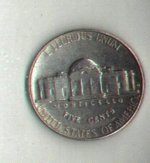Hey everyone!
I'm in the midst of searching a box of nickels. So far, one war nickel, and a handful from the late thirties, early fourties and fifties.
A few questions.
Are there any key coins/dates I should seek?
For all of you nickel roll hunters, what dates do you keep?
Additionally, why is it that ALL the 1964 nickels I pull look to be more silver than any others I've seen?
I don't understand it. There are so many, and I keep getting fooled. I'm not a precious metal expert, nor am I a complete novice... But I tell you, the 64's show the wear and tarnish of other silver items...
Maybe it's a government secret that they are silver indeed
I'm in the midst of searching a box of nickels. So far, one war nickel, and a handful from the late thirties, early fourties and fifties.
A few questions.
Are there any key coins/dates I should seek?
For all of you nickel roll hunters, what dates do you keep?
Additionally, why is it that ALL the 1964 nickels I pull look to be more silver than any others I've seen?
I don't understand it. There are so many, and I keep getting fooled. I'm not a precious metal expert, nor am I a complete novice... But I tell you, the 64's show the wear and tarnish of other silver items...
Maybe it's a government secret that they are silver indeed



